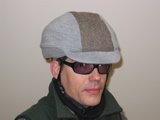Man on Wire
Jen, Mimi, and I rode bikes up to the Egyptian Theater last night to catch the new documentary Man on Wire, the thrilling account of aerialist Philipe Petit’s epic high-wire walk between the twin towers of the World Trade Center on August 7, 1974.
It was an amazing film about an even more amazing adventure, one so unbelievable that were it fiction, you wouldn’t believe it possible.
And of course, as most of the reviews I’ve read have pointed out, it’s all the more poignant given the events of September 11, 2001, which, also poignantly, are never once mentioned during the film.
You couldn’t help thinking how much simpler the world seemed thirty years ago—with handmade pasted-up security badges that could fool inattentive guards. (I was reminded how I used White-Out and a typewriter to modify the birthdate on my driver’s license—and it worked!)
I have a vague but oddly clear memory of Petit’s walk—or at least the reporting of it.
My family was at the New Jersey shore, sharing a beach house with our parent’s good friends, Mary and Harold Corsini. My own friend, Michael, had come with us and he and I were amusing ourselves that week by getting up as early as we could to take acid and walk along the waves.
What I recall best was looking at the photo on the front page of the New York Times the next day as we were coming down from the morning’s adventure and then going outside to draw lines in the wet sand near the surf and try unsuccessfully to walk along them without falling.
This was soon after hearing that Nixon had just resigned the presidency, so—even to my 17 year-old perspective—the world seemed particularly topsy-turvy.
Somehow, though, Petit’s feat made balance believable, and while we fell to the sand again and again, laughing crazily simply because we weren’t plummeting, it seemed, after all, that a few steps forward would still be possible.
It was an amazing film about an even more amazing adventure, one so unbelievable that were it fiction, you wouldn’t believe it possible.
And of course, as most of the reviews I’ve read have pointed out, it’s all the more poignant given the events of September 11, 2001, which, also poignantly, are never once mentioned during the film.
You couldn’t help thinking how much simpler the world seemed thirty years ago—with handmade pasted-up security badges that could fool inattentive guards. (I was reminded how I used White-Out and a typewriter to modify the birthdate on my driver’s license—and it worked!)
I have a vague but oddly clear memory of Petit’s walk—or at least the reporting of it.
My family was at the New Jersey shore, sharing a beach house with our parent’s good friends, Mary and Harold Corsini. My own friend, Michael, had come with us and he and I were amusing ourselves that week by getting up as early as we could to take acid and walk along the waves.
What I recall best was looking at the photo on the front page of the New York Times the next day as we were coming down from the morning’s adventure and then going outside to draw lines in the wet sand near the surf and try unsuccessfully to walk along them without falling.
This was soon after hearing that Nixon had just resigned the presidency, so—even to my 17 year-old perspective—the world seemed particularly topsy-turvy.
Somehow, though, Petit’s feat made balance believable, and while we fell to the sand again and again, laughing crazily simply because we weren’t plummeting, it seemed, after all, that a few steps forward would still be possible.


0 Comments:
Post a Comment
<< Home